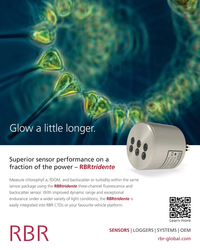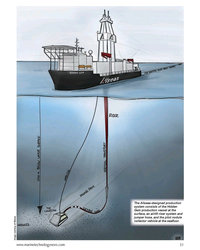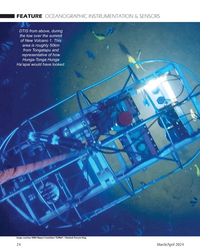Sensor Systems
-
- MTR100 '13 CONTROS Systems & Solutions GmbH Marine Technology, Jul 2013 #69
Wischhofstr. 1-3 Kiel, Schleswig-Holstein, Germany 24148
Tel: +4943126095900
E-mail: [email protected]
Website: www.contros.eu
CEO/President: Daniel Esser
Vice President: Volker Sallandt
Employees: 21The Case:
CONTROS was estbalished in 2006 as a GmbH and is a leader for dissolved gas measurements and building systems for the total carbon cycle helping to understand ocean acidification. Also Contros is in the forefront for early leak detection at subsea structures conserving the subsea environment.
The Company:
The Kiel, Germany, based CONTROS Systems & Solutions GmbH develops, produces and markets in-situ underwater sensor systems to detect hydrocarbons (e.g. methane), CO2 and oil in water (polycyclic aromatic hydrocarbons, PEG) down to a full ocean depth in any condition. The company’s products are mainly used for early leak detection and environmental assessment within the Offshore Oil & Gas industry, ranging from mobile inspections of pipelines and subsea structures to stationary Monitoring, Measurement and Verification (MMV) systems for subsea structures. The versatile CO2 systems are widely used for scientific campaigns in the field of climate studies, methane hydrate research, air-sea exchange and ocean acidification, CO2 sequestration applications (CCS), fish farming and limnology.
The Tech:
CONTROS’ aim is to sustain the current strength and to develop new technologies in order to deliver sensor systems to measure the total carbonate system in any liquid application ranging from pH, CO2 through to TA. With the HydroC CONTROS overcomes the fact that it is not possible to measure dissolved and gaseous methane (CH4) and carbon dioxide (CO2) directly in the water phase (in-situ) by combining the proven and highly precise non-dispersive infrared technology (NDIR, Laser) with a unique and worldwide patented membrane module.(As published in the July/August 2013 edition of Marine Technologies - www.seadiscovery.com)
-
- Jofra Offers Literature On Range Of Johansen Temperature Calibrators Maritime Reporter, Apr 1983 #111
distributed to the American market by Jofra, Inc., Houston, Texas. The electronic temperature calibrators can measure all wellknown temperature sensor systems, without use of liquids in the range of minus 50 to plus 1200 degrees F with a precision of plus or minus 0.5 percent, plus 1 digit. All
-
- Where Is the All-Electric Navy? Maritime Reporter, Nov 2001 #36
shipboard requirements. IPS will enable the instantaneous power switching and distribution among propulsion, ship service, and combat, weapon, and sensor systems without loss of loads or degradation in quality of power. • All elements of a warship's signaturesacoustic, infrared, radar cross section, magnetic
-
- Unmanned Surface Vessels: C-Stat Mobile Buoy USV System Marine Technology, May 2013 #34
, acoustic modem/positioning, ADCPs, magnetometers, CDT, weather station, environmental sensors, passive acoustic monitoring and security related sensor systems, including video, camera and infrared systems. C-Stat Specifications Hull length 2.5m Breadth 1.5m Propulsion Diesel-electric Duration
-
- Blue Tech Economy and the 'View from the Top' Marine Technology, Dec 2014 #10
Blue Economy further faster. Participants in the panel included: Brett Andrews, President, Hydranautics William Kikendall, President, Teledyne Marine Sensor & Systems David Millar, President, Fugro Pelagos Casey Moore, President, Sea-Bird Electronics Drew Stephens, Ocean Industry Manager, Esri Christopher
-
- Keeping a Watchful Eye Maritime Reporter, Sep 2015 #26
are a known threat and some protections are available and in place, it is the author’s opinion that more attention could be paid to securing integrated sensor systems. In designing and evaluating a multi-sensor SA systems objectives include but are not limited to: • Scalability and interoperability meeting
-
- Maritime Surveillance in the New Millennium Marine Technology, Sep 2015 #24
are a known threat and some protections are available and in place, it is the author’s opinion that more attention could be paid to securing integrated sensor systems. In designing and evaluating a multi-sensor SA systems objectives include but are not limited to: Scalability and interoperability
-
- MTR100 '13: Teledyne Benthos, Teledyne Webb Research & Teledyne Gavia Marine Technology, Jul 2013 #49
and battery replacement. While compact and “low logistics” the Gavia is also extremely capable, rated to 1000 meters depth and proven with a variety of sensor systems. As an Icelandic technology and compatible with sensors from other international sources, the Gavia AUV is widely exportable and the chosen low
-
- MTR 100: Battelle Marine Technology, Aug 2015 #16
and systems for maritime and underwater applications. Its high-speed data communicators, oil spill detection and tracking systems, and autonomous sensor systems are just some of the maritime technologies that help provide safe, accurate exploration and monitoring in harsh environments. A wholly owned subsidiary
-
- Royal Schelde Launches Second Frigate In New Series Maritime Reporter, May 1989 #57
The Sensor-, Weapon-, and Command System (SEAWACO) also makes the M-frigates highly suitable for crisis management operations. Some of weapons and sensor systems aboard the Doorman Class will include: PHS hull-mounted sonar; active and passive electronic warfare; satellite communication; Decca navigation and
-
- Overview Of Coast Guard's Fiscal Year 1991 Request Maritime Reporter, Jul 1990 #36
main areas of interest are the patrol boat capability replacement, the WHEC FRAM, WMEC MMA, and the development and evaluation of electrooptical sensor systems for USCG vessels. Ice Operations In the area of polar and domestic ice operations, the Coast Guard has requested $112 million in the FY91 budget
-
- MTR100 '13 Battelle Marine Technology, Jul 2013 #10
and systems for maritime and underwater applications. Our high-speed data communicators, oil spill detection and tracking systems, and autonomous sensor systems are just some of the maritime technologies that will help provide safe, accurate exploration and monitoring in harsh environments. A wholly owned
-
 )
March 2024 - Marine Technology Reporter page: 4th Cover
)
March 2024 - Marine Technology Reporter page: 4th CoverGlow a little longer. Superior sensor performance on a rmance on a – – RBRtridentfraction of the power RBRtridente teee ackscatter or turbidity with hi i in n n t t th h h he e e s sa a am m m me Measure chlorophyll a, fDOM, and backscatter or turbidity within the same e e sensor package using the
-
 )
March 2024 - Marine Technology Reporter page: 48
)
March 2024 - Marine Technology Reporter page: 48Index page MTR MarApr2024:MTR Layouts 4/4/2024 3:19 PM Page 1 Advertiser Index PageCompany Website Phone# 17 . . . . .Airmar Technology Corporation . . . . . . . . . .www.airmar.com . . . . . . . . . . . . . . . . . . . . . . . . . . . . . . . . .(603) 673-9570 9 . . . . . .Birns, Inc. . . . . . . . . . .
-
 )
March 2024 - Marine Technology Reporter page: 45
)
March 2024 - Marine Technology Reporter page: 45zero carbon emissions • Teledyne Marine Acquires Valeport Teledyne Marine agreed to acquire Valeport a leader in the design and manufacture of underwater sensors and pro? l- ers. Valeport is one of the UK’s leading manufacturers of oceanographic and hydrographic instrumentation. The in- dependent family-owned
-
 )
March 2024 - Marine Technology Reporter page: 44
)
March 2024 - Marine Technology Reporter page: 44team. Image courtesy Unique Group Sealing the deal(s) @ Oi ‘24 mating the object identi? cation process using the SAS Target in a single work? ow. The sensor’s 360-degree scanner and Assistant. The application runs in the background, leaving us- high collection rate provides a premier solution for mapping
-
 )
March 2024 - Marine Technology Reporter page: 43
)
March 2024 - Marine Technology Reporter page: 43Image courtesy Kongsberg Discovery Image courtesy Teledyne Marine New Products Teledyne Marine had its traditional mega-booth at Oi, busy start to ? nish. Image courtesy Greg Trauthwein offers quality sub-bottom pro? ling capability without the need tion of offshore windfarms. GeoPulse 2 introduces new
-
 )
March 2024 - Marine Technology Reporter page: 42
)
March 2024 - Marine Technology Reporter page: 42NEW TECH OCEANOLOGY INTERNATIONAL 2024 Image courtesy Greg Trauthwein Image courtesy BIRNS MacArtney launches the new ultra-compact ø12.7 mm SubConn Nano connector. Innovative connectivity built on 45 years of ? eld-proven and market-trusted design. Image courtesy MacArtney Birns celebrated its 70th
-
 )
March 2024 - Marine Technology Reporter page: 41
)
March 2024 - Marine Technology Reporter page: 41. This evolution led to a compre- hensive redesign of the vehicle’s internal layout, integration of updated components, and optimization of sensor systems to accommodate a broader range of instruments while maintain- Images courtesy MTR ing operational ef? ciency. The new generation Quadroin now
-
 )
March 2024 - Marine Technology Reporter page: 40
)
March 2024 - Marine Technology Reporter page: 40NEW TECH OCEANOLOGY INTERNATIONAL 2024 All photos courtesy MTR unless otherwise noted NEW TECH, PARTNERSHIPS LAUNCH IN LONDON With Oceanology International now one month in the rear-view mirror, MTR takes a look at some of the interesting technologies launched before, during and after the London event.
-
 )
March 2024 - Marine Technology Reporter page: 39
)
March 2024 - Marine Technology Reporter page: 39Photo courtesy Global Ocean Design Figure 7 A 35Ah AGM lead-acid battery is tested using the West Mountain Radio CBA to show the effect of simply ? lling the battery voids with mineral oil as a compensating ? uid. The CBA is programmed to cut-off at a voltage of 10.50v. The top line (red) shows the
-
 )
March 2024 - Marine Technology Reporter page: 38
)
March 2024 - Marine Technology Reporter page: 38LANDER LAB #10 Photo courtesy West Mountain Radio Photo courtesy of Clarios/AutoBatteries.com Figure 6 The West Mountain Radio Computerized Battery Analyzer (CBA V) attaches to a Figure 5 laptop by a USB-B cable, and to a battery by Powerpole® Connectors. Exploded view of an AGM lead-acid battery.
-
 )
March 2024 - Marine Technology Reporter page: 37
)
March 2024 - Marine Technology Reporter page: 37miscible barrier ? uid heavier than seawater (sg=1.026) and lighter than the battery electrolyte (sg=1.265). The original cell vent cap was screwed into the top of the riser pipe to vent the gases associated with charging. Wires were soldered to the lead (Pb) posts. The lead-acid battery was additionall
-
 )
March 2024 - Marine Technology Reporter page: 36
)
March 2024 - Marine Technology Reporter page: 36LANDER LAB #10 Of special interest for marine applications, LiPo batteries are Shipping any kind of lithium battery can be a challenge, and offered in a “pouch” design, with a soft, ? at body. The pouch IATA regs vary with the batteries inside or outside an instru- is vacuum-sealed, with all voids ?
-
 )
March 2024 - Marine Technology Reporter page: 33
)
March 2024 - Marine Technology Reporter page: 33regulated industry in the world.” How- ever, commercial success depends on many factors, not least a predictable OPEX. Over the past four years, SMD has worked with Oil States Industries to calculate cost per tonne ? gures for prospective customers. Patania II uses jet water pumps to Oil States’
-
 )
March 2024 - Marine Technology Reporter page: 32
)
March 2024 - Marine Technology Reporter page: 32FEATURE SEABED MINING by a sea? oor plume from its pilot collection system test. pact, nodule collection system that utilizes mechanical and The Metals Company recently signed a binding MoU with hydraulic technology. Paci? c Metals Corporation of Japan for a feasibility study on The company’s SMD
-
 )
March 2024 - Marine Technology Reporter page: 31
)
March 2024 - Marine Technology Reporter page: 31The Allseas-designed production system consists of the Hidden Gem production vessel at the surface, an airlift riser system and jumper hose, and the pilot nodule collector vehicle at the sea? oor. Image courtesy of Allseas www.marinetechnologynews.com 31 MTR #3 (18-33).indd 31 4/4/2024 2:12:41
-
 )
March 2024 - Marine Technology Reporter page: 30
)
March 2024 - Marine Technology Reporter page: 30a routing system that keeps the Digital twin technology analyzes data gathered from mul- umbilical in a single plane during collector operations. tiple sensors and assets to enable 3D visualization of op- The collector’s front-mounted Coandã-effect nozzles guide erations in real time. AI modelling can then
-
 )
March 2024 - Marine Technology Reporter page: 29
)
March 2024 - Marine Technology Reporter page: 29n January, Norway said “yes” to sea- bed mining, adding its weight to the momentum that is likely to override the calls for a moratorium by over 20 countries and companies such as I Google, BMW, Volvo and Samsung. Those against mining aim to protect the unique and largely unknown ecology of the sea?
-
 )
March 2024 - Marine Technology Reporter page: 26
)
March 2024 - Marine Technology Reporter page: 26FEATURE OCEANOGRAPHIC INSTRUMENTATION & SENSORS Kevin Mackay, TESMaP voyage leader and Center head of the South and West Paci? c Regional Centre of Seabed 2030. Kevin in the seismic lab at Greta Point looking at the Hunga Tonga-Hunga Ha’apai volcano 3D map completed with data from the TESMaP voyage
-
 )
March 2024 - Marine Technology Reporter page: 25
)
March 2024 - Marine Technology Reporter page: 25Maxlimer mapped the shape of the Wavelet 2KW at 250ms Ping Rate CorrelaO on > 0.96 caldera and measured the environmental conditions of water above it. Sensors on board collected additional data, explained SEA-KIT Operations Director Ash Skett, including bathymetric and water column backscatter conditions
-
 )
March 2024 - Marine Technology Reporter page: 24
)
March 2024 - Marine Technology Reporter page: 24FEATURE OCEANOGRAPHIC INSTRUMENTATION & SENSORS DTIS from above, during the tow over the summit of New Volcano 1. This area is roughly 50km from Tongatapu and representative of how Hunga-Tonga Hunga Ha’apai would have looked. Image courtesy NIWA-Nippon Foundation TESMaP / Rebekah Parsons-King 24
-
 )
March 2024 - Marine Technology Reporter page: 22
)
March 2024 - Marine Technology Reporter page: 22FEATURE OCEANOGRAPHIC INSTRUMENTATION & SENSORS Aerial view of HT-HH volcano, showing new multibeam depth data overlaid on islands satellite image. © SEA-KIT, NIWA-Nippon Foundation TESMaP 22 March/April 2024 MTR #3 (18-33).indd 22 4/4/2024 9:08:10 AM
-
 )
March 2024 - Marine Technology Reporter page: 19
)
March 2024 - Marine Technology Reporter page: 19About the Author vey with the pipe tracker is not required, resulting in signi? - Svenn Magen Wigen is a Cathodic Protection and corrosion control cant cost savings, mainly related to vessel charter. expert having worked across The major advantage of using FiGS on any type of subsea engineering, design
-
 )
March 2024 - Marine Technology Reporter page: 18
)
March 2024 - Marine Technology Reporter page: 18opportunistically when In contrast, a new generation high sensitivity ? eld gradi- in the vicinity. FiGS, however, revolutionizes this process by ent sensor for use on ROVs and AUVs developed by FORCE providing detailed insights into the lifespan of the CP system. Technology employs a novel approach with
-
 )
March 2024 - Marine Technology Reporter page: 17
)
March 2024 - Marine Technology Reporter page: 17quality and value improves through the use of non-con- the steel structure and the anodes, either by divers or ROVs. tact surveys using ? eld gradient sensor technology. Standard The probe typically consists of one or two silver/silver chlo- sensors in this ? eld work by detecting potential differences
